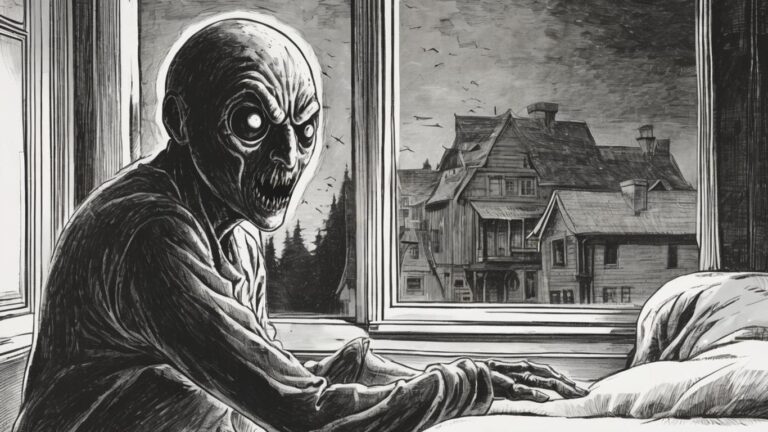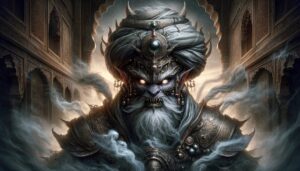Table of Contents
The Bogeyman is a mythical creature often used by parents or caregivers to frighten children into good behavior. The concept of the Bogeyman varies across cultures, but it generally involves a malevolent being who is said to come for misbehaving children. The Bogeyman is often used as a cautionary tale to encourage obedience and good conduct.
The specific characteristics and appearance of the Bogeyman can differ widely depending on cultural traditions. In some cultures, the Bogeyman is depicted as a monster or ghost, while in others, it may be a more humanoid figure. The name “Bogeyman” itself has variations, such as “Boogeyman” or “Bogieman.”
Bogeyman intention is to instill a sense of fear or discipline in children, although the methods and stories used to achieve this vary widely across different societies.
Bogeyman origin
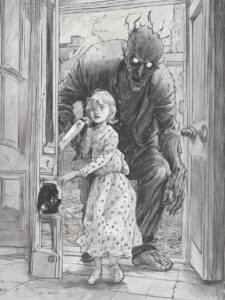
The concept of the Bogeyman has ancient roots and variations can be found in folklore and mythology across different cultures. The idea of a malevolent figure or spirit that scares children into good behavior is a common theme in many societies. Here are a few examples of the Bogeyman from various cultural traditions:
England: In English folklore, the Bogeyman is often depicted as a creature used by adults to frighten children into obedience. The name “Bogeyman” might be derived from the Middle English word “bogge,” meaning a frightening creature.
Germany: In Germany, there is a similar figure known as the “Butzemann” or “Buhmann.” This creature is said to come for naughty children.
Scandinavia: In Scandinavian folklore, there’s the “Bäckahästen,” a water spirit that can take the form of a horse. It is sometimes used to scare children away from bodies of water.
Russia: The Russian equivalent is the “Babayaga,” a witch-like character who is often portrayed as a hag with a hut that stands on chicken legs. Babayaga is known for her unpredictable behavior and is sometimes used to instill fear in children.
Latin America: In some Latin American countries, the equivalent of the Bogeyman is known as “El Cuco” or “Coco.” The legend of El Cuco is often used to make children behave, with warnings that if they misbehave, El Cuco will come for them.
Middle East: In Middle Eastern folklore, there’s a similar character known as “Abu Rigl Maslukha,” which translates to “Father Draped in Burnt Clothes.” This figure is sometimes used to scare disobedient children.
These examples highlight the cross-cultural nature of the Bogeyman archetype. The specific characteristics and stories associated with the Bogeyman vary widely, but the common thread is the use of a fearsome figure to encourage good behavior in children.
Physical Description
The physical description of the Bogeyman can vary widely depending on cultural traditions and individual interpretations. Since the Bogeyman is a mythical and folkloric figure, there isn’t a standardized appearance. Instead, the creature’s characteristics are shaped by the stories and beliefs of different cultures. Here are some general features that might be associated with the Bogeyman:
Monstrous Appearance: Many depictions of the Bogeyman involve a monstrous or supernatural appearance. This could include features such as sharp claws, fangs, horns, or other frightening attributes.
Shadowy or Shape-shifting Nature: In some cultures, the Bogeyman is described as a shadowy figure or a shape-shifter, making it difficult to pinpoint a specific form. This adds an element of mystery and fear.
Dark Clothing or Cloak: The Bogeyman is often associated with the night, darkness, or shadows. Therefore, it might be portrayed wearing dark clothing or a cloak that allows it to blend into the night.
Grotesque Facial Features: Facial features of the Bogeyman may be exaggerated or grotesque to enhance its frightening aspect. This could include large eyes, a menacing grin, or other features meant to evoke fear.
Variability: It’s important to note that the physical description of the Bogeyman is not fixed and can vary widely. Different cultures and even individual storytellers may have their own unique interpretations, leading to a diverse range of visual representations.
Humanoid or Non-Humanoid Form: While some depictions present the Bogeyman as a humanoid figure, others may portray it as a more abstract or non-humanoid entity, such as a supernatural force or a shapeless presence.
Cultural Influences: The physical attributes of the Bogeyman are often influenced by cultural beliefs, fears, and societal norms. For example, in cultures where certain animals are associated with fear or the supernatural, the Bogeyman might take on characteristics of those animals.
Personality
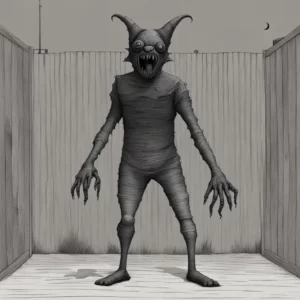
The Bogeyman, as a mythical and folklore figure, doesn’t typically have a detailed or consistent personality, as it is more of a symbolic representation of fear used to encourage good behavior in children. However, certain characteristics associated with the Bogeyman concept may imply a menacing or ominous presence. Here are some general traits that might be attributed to the personality of the Bogeyman:
Menacing: The Bogeyman is often portrayed as a menacing or threatening figure, meant to instill fear in children. Its presence is used as a deterrent to discourage disobedience.
Disciplinary: The primary purpose of the Bogeyman is to serve as a disciplinary tool. It is used by parents or caregivers to warn children that misbehavior may lead to the Bogeyman coming to take them away.
Mysterious: The Bogeyman is frequently depicted as a mysterious and elusive figure, adding to the fear associated with it. Its unpredictable nature may contribute to the effectiveness of the cautionary tale.
Nightmarish: Given its association with fear and the dark, the Bogeyman may be linked to nightmares. Stories about the Bogeyman often play on common childhood fears to create a sense of unease.
Unpredictable: The Bogeyman is sometimes described as unpredictable, making it challenging for children to anticipate its actions. This unpredictability may heighten the fear associated with the figure.
Enforcing Morality: The Bogeyman is a moralistic figure, used to enforce societal norms and values. It serves as a cautionary tale, reinforcing the idea that misbehavior will have consequences.
Cultural Variation: The personality traits associated with the Bogeyman can vary across cultures. In some stories, the Bogeyman may be depicted as a more malevolent or vengeful entity, while in others, it might be a neutral force used for educational purposes.
Bogeyman’s Around the World
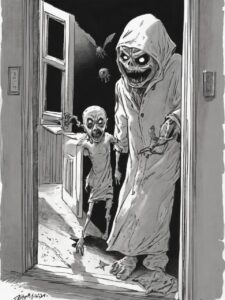
Wewe Gombel (Indonesia)
Origin and Description: Wewe Gombel is a folklore figure from Javanese mythology in Indonesia. The legend tells of a ghostly woman who kidnaps children, particularly those who are naughty or disobedient. She is often described as a tall, thin woman with long hair and wears a white robe.
Purpose: Wewe Gombel is used as a cautionary figure to encourage good behavior in children. Parents might warn their children that Wewe Gombel will come for them if they misbehave.
Baba Yaga (Russia)
Origin and Description: Baba Yaga is a witch-like character from Slavic folklore, particularly in Russian and Eastern European traditions. She is often portrayed as an old, hag-like woman who flies around in a mortar, lives in a hut that stands on chicken legs, and is known for her unpredictable and sometimes menacing behavior.
Purpose: Similar to the Bogeyman, Baba Yaga is used in folk tales to scare children into behaving. She is a complex character, sometimes appearing as a villain and at other times helping protagonists.
El Cuco (Latin America)
Origin and Description: El Cuco, also known as Coco, is a figure present in the folklore of various Latin American countries. It is often described as a shape-shifting monster or ghost used to scare children into obedience. The specifics of El Cuco’s appearance can vary.
Purpose: Parents might warn their children that El Cuco will come for them if they misbehave or refuse to sleep. The threat of El Cuco is used as a means of ensuring good behavior.
The Babadook (Australia)
Origin and Description: While not a traditional folklore figure, The Babadook gained recognition through the 2014 Australian horror film of the same name. In the film, The Babadook is a sinister presence that torments a mother and her son. It is depicted as a dark, otherworldly creature.
Purpose: In the context of the film, The Babadook represents the mother’s grief and psychological struggles. While not a traditional Bogeyman, it taps into the theme of fear and the unknown.
Explanation of the Myth

Menacing Presence:
The Bogeyman is often portrayed as a malevolent and frightening figure.
Its purpose is to serve as a deterrent for misbehavior in children, creating a sense of fear that encourages compliance.
Disciplinary Tool:
Parents or caregivers use the idea of the Bogeyman as a disciplinary tool.
Children are warned that if they misbehave or disobey rules, the Bogeyman will come for them as a consequence.
Cultural Variations:
The Bogeyman concept is not uniform and varies across cultures. Different regions have their own versions with unique names, appearances, and backstories.
In some cultures, the Bogeyman is depicted as a supernatural creature, while in others, it may be a more human-like figure.
Cautionary Tale:
Stories about the Bogeyman often serve as cautionary tales, teaching children about the consequences of disobedience or undesirable behavior.
The fear associated with the Bogeyman is intended to shape children’s behavior and encourage them to follow societal norms.
Use of Imagination:
The myth of the Bogeyman often plays on children’s imaginations and fears of the unknown.
Its vague and mysterious nature allows for adaptation based on the cultural context and the specific fears prevalent in a society.
Nighttime Association:
The Bogeyman is commonly associated with the nighttime and darkness, contributing to the fear of the unknown that often accompanies nighttime for children.
This association may be used to encourage bedtime compliance and good sleeping habits.
Role in Folklore:
The Bogeyman is a prevalent figure in folklore and has been used for generations as a means of socializing children.
While its details may change, the overarching purpose remains consistent: to guide and regulate children’s behavior through the instillation of fear.
Bogeyman is a cultural construct, a mythical entity that plays a significant role in shaping children’s behavior through the fear of potential consequences for misbehavior. Its characteristics and stories may vary, but its purpose as a disciplinary figure is a common thread across cultures.
Bogeyman Symbolism

The Bogeyman, as a cultural and folkloric symbol, carries several layers of symbolism that extend beyond its literal representation. Here are some key aspects of the Bogeyman’s symbolism:
Fear and Authority:
Symbol of Fear: The Bogeyman embodies fear, representing the unknown and the consequences of disobedience. It is a tool to instill fear in children, making them more likely to comply with societal rules and parental authority.
Authority Figure: The Bogeyman symbolizes authority, often parental or societal, as it is used to enforce behavioral norms. It reinforces the idea that certain actions have consequences.
Cultural Values and Norms:
Enforcement of Norms: The Bogeyman is a cultural mechanism for enforcing societal norms and values. It serves as a cautionary figure, encouraging adherence to cultural expectations and standards of behavior.
Transition to Adulthood:
Rite of Passage: The fear of the Bogeyman is sometimes used as part of a child’s rite of passage, emphasizing the transition from childhood to adulthood. Overcoming or outgrowing the fear may be seen as a step toward maturity.
Imagination and Creativity:
Stimulation of Imagination: The concept of the Bogeyman stimulates children’s imaginations and creativity. It taps into the universal fear of the unknown and encourages storytelling within cultures.
Symbol of Fantasy: As a fantastical figure, the Bogeyman represents the blurred line between reality and imagination, showcasing the power of storytelling and myth in shaping beliefs.
Psychological Development:
Development of Conscience: The fear of the Bogeyman contributes to the development of a child’s conscience. It introduces the concept of consequences for actions and helps internalize societal norms.
Nighttime and Darkness:
Fear of the Dark: The Bogeyman’s association with nighttime and darkness reflects the primal fear of the unknown that often accompanies the night. This symbolism is used to encourage bedtime compliance and good sleeping habits.
Cultural Adaptability:
Cultural Specificity: The Bogeyman’s characteristics can be highly culture-specific, adapting to local beliefs, fears, and societal values. This adaptability reflects the dynamic nature of folklore and storytelling within different communities.
Parental Guidance:
Parental Protection: The Bogeyman can symbolize a parent’s protective role by warning children of potential dangers. In this sense, the fear associated with the Bogeyman may be a means of promoting safety and caution.
In history and Modern Usage
Historical Significance
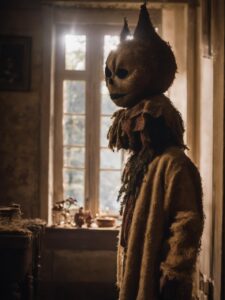
Ancient Roots:
The concept of a malevolent figure used to enforce social norms and discipline children has ancient roots. Various cultures have had folklore figures with similar roles throughout history.
Medieval Europe:
During medieval times in Europe, tales of creatures like the Bogeyman were used as cautionary tales. These stories often had moral lessons and were employed as a way to instill fear and maintain social order.
Modern Usage
Parental Guidance:
Parents and caregivers continue to use the idea of the Bogeyman as a tool for managing children’s behavior. The threat of the Bogeyman is sometimes employed to encourage good conduct and obedience.
Pop Culture:
The Bogeyman concept has permeated various forms of popular culture, including literature, movies, and television. Numerous books, movies, and TV shows feature characters or entities inspired by the Bogeyman.
Children’s Literature:
The Bogeyman appears in a variety of children’s books, often as a character that protagonists must confront or overcome. These stories may explore themes of courage, facing fears, and personal growth.
Cultural Variations:
Different cultures continue to have their own versions of the Bogeyman. These variations reflect the unique beliefs and fears within each cultural context. For example, the Wewe Gombel in Indonesia or El Cuco in Latin America.
Psychological Perspectives:
From a psychological standpoint, the Bogeyman is sometimes discussed in the context of childhood development. The fear associated with such figures is seen as a natural part of a child’s cognitive and emotional development.
Educational Purposes:
The Bogeyman has been used in educational settings to explore topics such as storytelling, cultural diversity, and the psychology of fear. Teachers may use these stories to engage students in discussions about folklore and cultural traditions.
Adaptation in Horror:
In horror genres, the concept of the Bogeyman has been adapted and sometimes reimagined to create suspenseful and frightening narratives. The idea of a mysterious and malevolent entity preying on individuals is a recurring theme in horror literature and cinema.
Internet Memes and Urban Legends:
The Bogeyman concept has found its way into modern internet culture, with various memes, urban legends, and online stories incorporating similar themes. These digital adaptations often reflect contemporary fears and anxieties.
In both history and modern usage, the Bogeyman remains a potent cultural symbol that continues to shape narratives and conversations about fear, morality, and the development of social values. Its adaptability across time and cultures underscores its enduring significance in the realm of folklore and storytelling.
FAQ
Who is the real boogeyman?
The Boogeyman is a mythical and folkloric figure with no real-world existence. It is a concept used in various cultures to scare children into good behavior.
Who is called boogeyman?
The term "Boogeyman" is a generic name used to describe a fictional creature or entity that is invoked to frighten children into behaving.
Who is The Boogeyman and what does he do?
The Boogeyman is a legendary creature or figure often depicted as a malevolent being that comes for misbehaving children. Its primary purpose is to serve as a cautionary figure, encouraging good behavior through the threat of its presence.
Who is boogeyman ghost?
The Boogeyman is not typically associated with being a ghost. It is more commonly depicted as a supernatural or monstrous entity used for disciplinary purposes.
Is the boogeyman true story?
No, the Boogeyman is not a true story. It is a cultural and folkloric concept used in various societies to teach children moral lessons and encourage good behavior.
Is Baba Yaga the Bogeyman?
While Baba Yaga and the Bogeyman share some similarities as mythical and frightening figures, they come from different cultural traditions. Baba Yaga is a witch-like character from Slavic folklore, and the Bogeyman is a more universal concept found in various cultures.
Is the Boogeyman good or bad?
The Boogeyman is typically portrayed as a menacing figure, and its purpose is to instill fear in children to encourage good behavior. In this context, it is seen as a "bad" or threatening entity.
Can the Boogeyman be killed?
The Boogeyman is a fictional character, so discussions about its mortality are within the realm of folklore and mythology. In most traditional stories, the Boogeyman's characteristics don't include being mortal or immortal in the same way as living beings.
Who made the Boogeyman?
The concept of the Boogeyman has evolved over time and is not attributed to a single creator. It is a cultural construct that has emerged independently in various societies as a means of encouraging good behavior in children.
Is The Boogeyman a Demon?
The Boogeyman is not consistently portrayed as a demon. It is more often depicted as a supernatural or monstrous figure used to invoke fear in children.
Why does the boogeyman exist?
The Boogeyman exists as a cultural construct to serve as a cautionary figure. Its purpose is to encourage children to behave according to societal norms and rules through the fear of potential consequences.
Why is the boogeyman a thing?
The concept of the Boogeyman persists because it serves as a powerful tool for parents and caregivers to manage children's behavior. The fear associated with the Boogeyman can be an effective means of teaching moral lessons.
What is the myth of the Bogeyman?
The myth of the Bogeyman involves a malevolent creature or figure used in folklore and stories to scare children into good behavior. The details of the myth vary across cultures, but the overarching theme is the use of fear to encourage obedience.
What is the Boogeyman's weakness?
The Boogeyman, being a fictional and symbolic figure, does not typically have defined weaknesses. Its power lies in the fear it instills rather than in any vulnerabilities.
Did Boogeyman ever lose?
In folklore and traditional stories, the outcome of encounters with the Boogeyman is often left ambiguous. The emphasis is usually on the moral lesson rather than the actual defeat or victory over the character.
Is Baba Yaga a girl?
Baba Yaga is often portrayed as an old and hag-like woman in Slavic folklore. The character is not a girl but rather an ancient and powerful figure with supernatural attributes.
Is Baba Yaga kind?
Baba Yaga's character is complex and can vary in different stories. In some tales, she is depicted as malevolent, while in others, she may play a more ambiguous or helpful role. The characterization of Baba Yaga depends on the specific cultural narrative.
Is Baba Yaga nice?
Baba Yaga is not typically described as a "nice" character. In many folk tales, she is portrayed as a powerful and unpredictable figure with her own agenda.
Does The Boogeyman eat kids?
The Boogeyman is not consistently depicted as an entity that eats children. Its primary role is to scare children into good behavior rather than to harm them physically.
Is the boogie man Immortal?
The immortality of the Boogeyman is not a consistent aspect of its folklore. As a mythical figure, discussions about mortality or immortality are generally not central to its character.
Is Michael Myers the boogie man?
In the context of the Halloween film series, the character Michael Myers is often referred to as "The Boogeyman." This designation emphasizes his relentless and unstoppable nature as a horror movie antagonist.
How tall is the Boogeyman?
The height of the Boogeyman is not consistently defined, as it is a mythical and symbolic figure that can take various forms in different cultural traditions and stories.
What is the Boogeyman in Russian?
In Russian folklore, the closest equivalent to the Boogeyman might be represented by characters like "Domovoi" (household spirit) or "Koschei the Deathless" (an evil figure). Baba Yaga, while distinct, is another character associated with Russian folklore.
What nationality is Bogeyman?
The concept of the Bogeyman is not associated with a specific nationality. It is a universal and cross-cultural folklore figure found in various forms across different societies.
What did Boogeyman eat?
Traditionally, the Boogeyman is not associated with eating children or any specific type of food. Its role is more focused on instilling fear to encourage good behavior.
Who is the Boogeyman married to?
The Boogeyman's marital status is not a consistent element in its folklore. The character is primarily used as a symbolic figure to teach moral lessons rather than having a detailed personal background.
